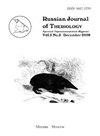The salt licking activity of the European Moose (Alces alces Linnaeus, 1758) in the Leningrad region of Russia: temporal and behavioral aspects
IF 0.6
4区 生物学
Q4 ZOOLOGY
引用次数: 1
Abstract
. Long-term monitoring (2015–2019) was carried out on artificial salt licks (a total of 19 in 3 districts). The total monitoring time was 7123 camera trap days. Depending on the place and year of monitoring, from 5 to 33 different individuals were recorded on each salt lick. Six sex and age groups were identified: adult males, yearling males, adult single females, yearling female, adult females with calves, adult females with yearling individuals. All duration data by sex and age groups including "passing" visits have the form of an exponential distribution (λ = 0.029 ± 0.001 min -1 ). The data of the duration of geophagous visits have the form of a gamma distribution ( k = 1.76 ± 0.087; θ = 21.20 ± 1.501 min). European Moose visit salt licks all year round, most actively in May-August. The average duration of a visit is close to half an hour for each of the identified groups (33.7 ± 1.3 min for all groups; clear time of geophagous visit is 33.2 ± 2.8 min). The duration of salt licking and the mineral lick attendance differs between some identified sex-age groups and months. During the days of salt licking, the same individual most often visits the lick several times (1 to 5 visits a day (max 11), on average 1.48 ± 0.39). The activity of visiting salt licks during the day has a pronounced tendency to acquire peak values in the twilight post-sunset and pre-dawn periods. The moose use a third of the month (34.9% ± 20.8% of month) for salt licking, alternating this with various-time periods break. Age and sex competition for the use of salt licks was noted.俄罗斯列宁格勒地区欧洲驼鹿(Alces Alces Linnaeus, 1758)舔盐活动:时间和行为方面
.对人工盐舔进行了长期监测(2015-2019年)(3个区共19个)。总监测时间为7123个摄像头捕捉日。根据监测的地点和年份,每次盐舔都会记录5到33个不同的个体。确定了六个性别和年龄组:成年雄性、一岁雄性、成年单身雌性、一岁雌性、带幼崽的成年雌性、带一岁个体的成年雌性。所有按性别和年龄组划分的持续时间数据,包括“通过”就诊,均呈指数分布形式(λ=0.029±0.001 min-1)。食地动物访问持续时间的数据具有伽马分布的形式(k=1.76±0.087;θ=21.20±1.501分钟)。欧洲驼鹿一年四季都会去舔盐,最活跃的是在5月至8月。每个确定的组的平均访视持续时间接近半小时(所有组为33.7±1.3分钟;食地访视的净时间为33.2±2.8分钟)。舔盐的持续时间和舔矿物质的次数在一些确定的性别年龄组和月份之间有所不同。在舔盐的日子里,同一个人最常去舔几次(每天1到5次(最多11次),平均1.48±0.39次)。白天去舔盐的活动在日落后的黄昏和黎明前有明显的峰值趋势。驼鹿用一个月的三分之一(34.9%±20.8%)舔盐,并在不同的休息时间交替进行。人们注意到在使用盐舔方面存在年龄和性别竞争。
本文章由计算机程序翻译,如有差异,请以英文原文为准。
求助全文
约1分钟内获得全文
求助全文
来源期刊

Russian Journal of Theriology
Agricultural and Biological Sciences-Animal Science and Zoology
CiteScore
0.90
自引率
33.30%
发文量
0
期刊介绍:
The Russian Journal of Theriology publishes papers on all aspects of mammalian biology: taxonomy, zoogeography, ecology, behavior, morphology, development, physiology, paleontology, and evolution. Studies of extinct as well as extant taxa are included. Reviews are also published; these may be invited by the Editorial Board.
 求助内容:
求助内容: 应助结果提醒方式:
应助结果提醒方式:


